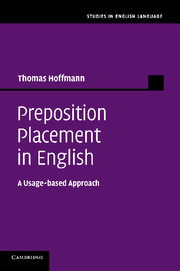Book contents
- Frontmatter
- Contents
- List of Figures
- List of Tables
- List of Abbreviations
- Acknowledgements
- 1 Introduction
- 2 Corroborating evidence: Data and methodology
- 3 Case notes: Independent factors
- 4 Evidence I: Corpus results
- 5 Evidence II: Experimental results
- 6 Preposition placement: The case for a Construction Grammar account
- 7 Conclusion: The verdict
- Online appendix
- References
- Index
7 - Conclusion: The verdict
Published online by Cambridge University Press: 04 February 2011
- Frontmatter
- Contents
- List of Figures
- List of Tables
- List of Abbreviations
- Acknowledgements
- 1 Introduction
- 2 Corroborating evidence: Data and methodology
- 3 Case notes: Independent factors
- 4 Evidence I: Corpus results
- 5 Evidence II: Experimental results
- 6 Preposition placement: The case for a Construction Grammar account
- 7 Conclusion: The verdict
- Online appendix
- References
- Index
Summary
This is something up with which I will not put.
(attributed to Sir Winston Churchill; Pullum and Huddleston 2002: 629)The above sentence is a much-quoted joke attributed to Sir Winston Churchill, who is supposed to have commented on a particularly stilted evasion of preposition-stranding with the words ‘This is something up with which I will not put’ (Pullum and Huddleston 2002a: 629). The sentence is intentionally ungrammatical since not only the preposition with has been pied-piped to the front of the clause, but also the particle up. Interestingly, though the sentence is clearly ungrammatical, it provides another piece of evidence for Construction Grammar approaches.
Searching for sentences similar to the quote on British internet sites on Google, for example, gives sixteen examples of the structure, nine of which have been adjusted in the following ways (emphasis, i.e. bold font, italics and brackets, added):
The first thing to note is that among the most variable slots of the sentence is the antecedent position: only (7.1e) has something as in the original quote. In addition to that, the subject position is also filled differently: we in (7.1a,b,f), she in (7.1c,e), he in (7.1i), they (7.1d), one (7.1g), and purists (7.1h). Furthermore, in (7.1f) the modal should is used instead of will. In contrast to this, the elements up with which … not put remain constant.
- Type
- Chapter
- Information
- Preposition Placement in EnglishA Usage-based Approach, pp. 276 - 278Publisher: Cambridge University PressPrint publication year: 2011



